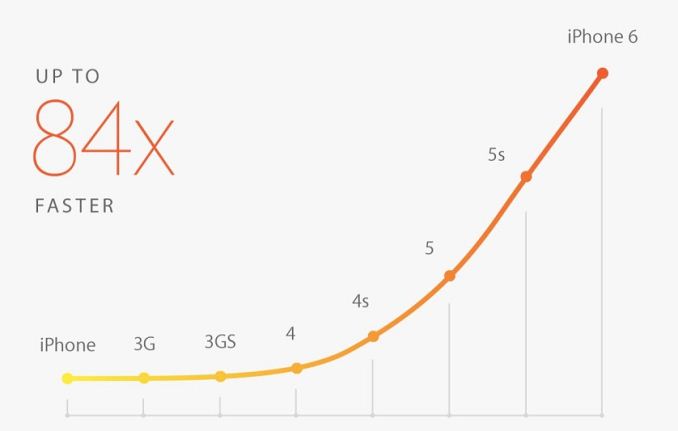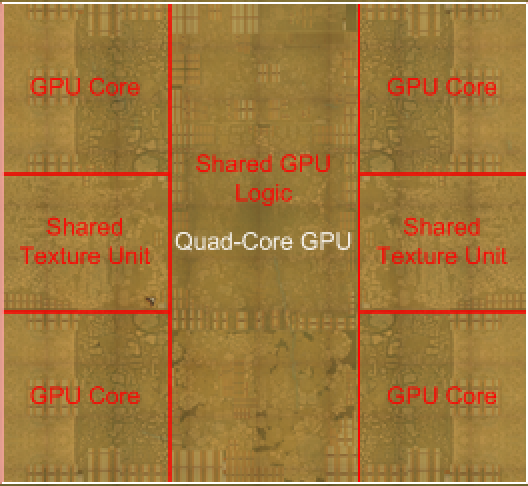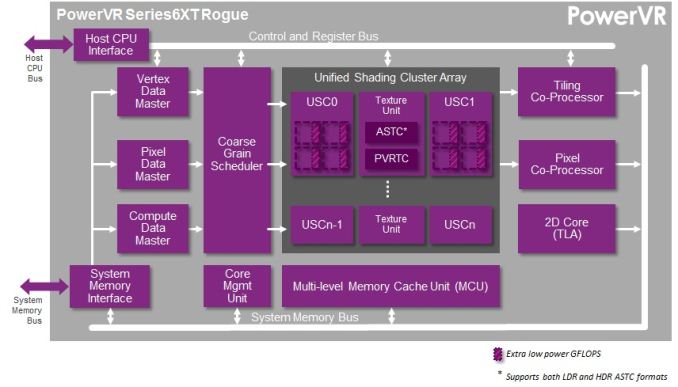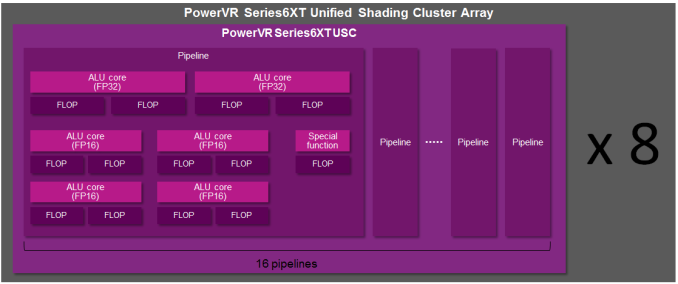The iPhone 6 Review
by Joshua Ho, Brandon Chester, Chris Heinonen & Ryan Smith on September 30, 2014 8:01 AM EST- Posted in
- Smartphones
- Apple
- Mobile
- iPhone 6
A8’s GPU: Imagination Technologies’ PowerVR GX6450
Last but not least on our tour of the A8 SoC is Apple’s GPU of choice, Imagination’s PowerVR GX6450.
When Apple first announced the A8 SoC as part of their iPhone keynote, they told us to expect a nearly 50% increase in graphics performance. Based on that information and on the fact that that Apple was moving to a denser 20nm process, we initially believed that Apple would be upgrading from A7’s 4-core PowerVR design to a 6-core design, especially in light of the higher resolution displays present on the iPhone 6 and iPhone 6 Plus.
Instead our analysis with Chipworks found that only four GPU cores were present on A8, which ruled out the idea of a 6-core design but did narrow down the options considerably. Based on that information and more importantly Apple’s Metal Programming Guide, we have been able to narrow down our options to a single GPU, the PowerVR GX6450.
The GX6450 is the immediate successor to the G6430 first used in the A7 and is based on Imagination’s PowerVR Series6XT architecture. Imagination first announced PowerVR Series6XT to the public at CES 2014, and now just a short eight months later we are seeing the first Series6XT hardware reach retail.
We have already covered the PowerVR Series6/Series6XT architecture in some detail earlier this year so we won’t go through all of it again, but we would encourage anyone who is interested to take a look at our architectural analysis for additional information. Otherwise we will be spending the bulk of our time looking at how GX6450 differs from G6430 and why Apple would choose this specific GPU.
From a technical perspective Series6XT is a direct evolution over the previous Series6, and GX6450 is a direct evolution over G6430 as well. Given a 4-core configuration there are only a limited number of scenarios where GX6450 outright has more hardware than G6430 (e.g. additional ALUs), and instead Series6XT is focused on adding features and improving performance over Series6 through various tweaks and optimizations to the architecture. Series6 at this point is actually over two years old – it was first introduced to the public at CES 2012 – so a lot has happened in the mobile GPU landscape over the past couple of years.
The closest thing to a marquee feature on Series6XT is support for Adaptive Scalable Texture Compression (ASTC), a next-generation texture compression technology that is slowly making its way into GPUs from a number of manufacturers. Designed by the consortium responsible for OpenGL ES, Khronos, ASTC is designed to offer better texture compression (with finer grained quality options) than existing texture compression formats while also being a universal format supported by all GPUs. In Apple’s case they have always been using PowerVR GPUs – and hence all products support PVRTC and more recently PVRTC2 – however ASTC being exposed allows them to take advantage of the quality improvements while also making game development and porting from other platforms easier.
Less visible to users but certainly important to Apple, Series6XT also includes new power management capabilities to reduce power consumption under idle and light workloads. Through finer grained power gating technology that Imagination dubs “PowerGearing G6XT”, GX6450 can now have its shading clusters (USCs) powered down individually, allowing only as many of them as are necessary to be fired up. As Apple continues to min-max their designs, being able to idle at a lower power state can be used to improve battery life and/or increase how often and how long the A8’s GPU uses higher power states, improving overall efficiency.

Apple iPhone GPU Performance Estimate: Over The Years
And, perhaps most importantly overall, Series6XT comprises a series of under-the-hood optimizations to improve overall performance. When it comes to the internals of PowerVR architectures we only have limited details from Imagination on how they operate, so in some areas we know quite a bit about what Imagination has been up to and in other areas their architectures are still something akin to a black box. At any rate Imagination’s goal for Series6XT was to improve performance by up to 50% – this seems to be where Apple’s 50% performance improvement claim comes from – though as we’ll see the performance gains on real world applications are not going to be quite as potent.
What we do know about Series6XT is that Imagination has made some changes to the structure of the USCs themselves. Series6XT still uses a 16-wide SIMD design, but in each pipeline they have added another set of medium/half-precision (FP16) ALUs specifically to improve FP16 performance. Now instead of 2x3 (6) FP16 ALUs, Series6XT bumps that up to 4x2 (8) FP16 ALUs. This is the only outright increase in shader hardware when you compare Series6 to Series6XT, and on paper it improves FP16 performance by 33% at equivalent clock speeds.
The focus on FP16 is interesting, though for iOS it may be misplaced. These half-precision floating point operations are an excellent way to conserve bandwidth and power by not firing up more expensive FP32 ALUs, but the tradeoff is that the numbers they work with aren’t nearly as precise, hence their use has to be carefully planned. In practice what you will find is that while FP16 operations do see some use, they are by no means the predominant type of floating point GPU operation used, so the FP16 increase is a 33% increase only in the cases where performance is being constrained by the GPU’s FP16 performance.
FP32 performance meanwhile remains unchanged. Each USC pipeline contains two such ALUs, for up to four FP32 FLOPS per clock, or to use our typical metric, 128 MADs (Multiply-Adds) per clock.
The rest of Series6XT’s optimizations take place at the front and back ends, where geometry processing and pixel fill take place respectively. Imagination has not told us exactly what they have done here, but both these areas have been targeted to improve sustained polygon rates and pixel fillrate performance. These more generic optimizations stand to be more applicable to general performance, though by how much we cannot say.
One final optimization we want to point out for Series6XT is that Imagination has made some additional under-the-hood changes to improve GPU compute performance. We have not talked about GPU compute on iOS devices thus far, as until now Apple has not exposed any APIs suitable for it (e.g. OpenCL is not available on iOS). With iOS8 Apple is releasing their Metal API, which is robust enough to be used for both graphics and now compute. How developers put this capability to use remains to be seen, but GX6450 should perform even better than G6430.
| Mobile SoC GPU Comparison | ||||||||||
| PowerVR SGX 543MP2 | PowerVR SGX 543MP3 | PowerVR SGX 543MP4 | PowerVR SGX 554MP4 | PowerVR G6430 | PowerVR GX6450 | |||||
| Used In | iPad 2/iPhone 4S | iPhone 5 | iPad 3 | iPad 4 | iPad Air/iPhone 5s | iPhone 6/iPhone 6Plus | ||||
| SIMD Name | USSE2 | USSE2 | USSE2 | USSE2 | USC | USC | ||||
| # of SIMDs | 8 | 12 | 16 | 32 | 4 | 4 | ||||
| MADs per SIMD | 4 | 4 | 4 | 4 | 32 | 32 | ||||
| Total MADs | 32 | 48 | 64 | 128 | 128 | 128 | ||||
| GFLOPS @ 300MHz | 19.2 GFLOPS | 28.8 GFLOPS | 38.4 GFLOPS | 76.8 GFLOPS | 76.8 GFLOPS | 76.8 GFLOPS | ||||
| Pixels/Clock | N/A | N/A | N/A | N/A | 8 | 8 | ||||
| Texels/Clock | N/A | N/A | N/A | N/A | 8 | 8 | ||||
The one wildcard when talking about performance here is going to be clock speeds. Apple doesn’t expose these and they aren’t easy to test for (yet), though in the long term Metal offers some interesting possibilities for nailing that down, or at least getting a better idea of relative clock speeds.
In any case, we’ll take a look at our GPU benchmarks in depth in a bit, but overall GPU performance compared to A7 and its G6430 is consistently better, but the exact performance gain will depend on the test at hand. Some tests will come very close to reaching 50% while others will be just 15-20%. The dependent factor generally seems to be whether the test is ALU-bound or not; because the USC has not changed significantly from G6430 to GX6450 outside of those additional FP16 ALUs, tests that hit the FP32 ALUs in particular show less of an improvement. Otherwise more balanced tests (or at least tests more defined by pixel fillrate performance) can show greater gains. In general we should be looking at a 30-35% performance improvement.
Why Four Cores?
One thing that admittedly surprised us in the revelation that A8 was using a 4-core PowerVR design was that we figured a 6-core design would be a shoe-in for A8, especially since Apple was on the receiving end of the density improvements from TSMC’s 20nm process. But upon further reflection an additional two cores is likely more than Apple needed nor wanted.
The biggest factor here is that coming from G6430 in the A7, performance has seen a solid improvement despite sticking to only four GPU cores. Due to the combination of performance improvements from the Series6XT architecture and any clock speed increases from Apple, A8 gets quite a bit more GPU performance to play with. The increased resolution of the iPhone 6 screen in turn requires more performance if Apple wants to keep native resolution performance from significantly regressing, which GX6450 is capable of delivering on. Never mind the fact that G6430 also drove the iPad Air and its much larger 2048x1536 pixel display.
| PowerVR Series6/6XT "Rogue" | ||||||||||||
| GPU | # of Clusters | # of FP32 Ops per Cluster | Total FP32 Ops | Optimization | ||||||||
| G6200 | 2 | 64 | 128 | Area | ||||||||
| G6230 | 2 | 64 | 128 | Performance | ||||||||
| GX6240 | 2 | 64 | 128 | Area | ||||||||
| GX6250 | 2 | 64 | 128 | Performance | ||||||||
| G6400 | 4 | 64 | 256 | Area | ||||||||
| G6430 | 4 | 64 | 256 | Performance | ||||||||
| GX6450 | 4 | 64 | 256 | Performance | ||||||||
| G6630 | 6 | 64 | 384 | Performance | ||||||||
| GX6650 | 6 | 64 | 384 | Performance | ||||||||
These performance improvements in Series6XT have a cost as well, and that cost is suitably reflected in the estimated die sizes for each GPU. The G6430 was 22.1mm2 on the 28nm A7, while the GX6450 is 19.1mm2 on A8. Though GX6450 is smaller overall, it’s nowhere near the roughly 11.1mm2 a pure and perfect die shrink of G6430 would occupy. Limited area scaling aside, GX6450’s additional functionality and additional performance requires more transistors, and at the end of the day Apple doesn’t see a significantly smaller GPU because of this. In other words, the upgrade from G6430 to GX6450 has delivered much of the performance (and consumed much of the die space) we initially expected to be allocated to a 6-core GPU.
Overall the choice of GX6450 seems to be one of picking the GPU best for a phone, which is an area the G6430 proved effective with A7. As a step below Imagination’s 6-core PowerVR designs, GX6450 delivers a better balance between performance and power than a larger GPU would, which in turn is clearly a benefit to Apple. On the other hand this means A8 is not going to have the GPU performance to compete with the fastest SoCs specifically designed for tablets, though what this could mean for the obligatory iPad update remains to be seen.













531 Comments
View All Comments
Samus - Tuesday, September 30, 2014 - link
tl/drAceMcLoud - Tuesday, September 30, 2014 - link
lol, retardroids crack me upninjaroll - Tuesday, September 30, 2014 - link
LOL. That's pretty sad. I would NEVER spend more than 2 minutes writing about a product I don't intend on using. You seem a LITTLE obsessed with Apple judging by your username. But I applaud you for having so much free time, must be nice having so much disposable time. I say you focus on using whatever works for you.bigstrudel - Tuesday, September 30, 2014 - link
It took a second to scroll by your post, but I had to scroll back up to read your line"Last but not least, every Apple product includes a direct hotlink to the NSA, free of charge, something that might make it a good value, after all."
Wait. Apple is the one with NSA connections?
Aljazeera released emails that show Google's founders speaking with the NSA director on a first name basis.
In 2004, Google bought Keyhole, a geospatial data visualization company with history and investments made by the CIA. Keyhole's marquee application suite, Earth Viewer, emerged as Google Earth in 2005 while other aspects of its technology were integrated into Google Maps.
SELinux was created by the NSA for "security purposes" and is included on Android with Google's permission. It cannot be disabled.
Do you think AOSP will save you with it's "millions of eyes" strategy? Wrong. Google Apps are closed source and cannot be removed by 99% of the population.
Yes. We don't really know what happens to the data that Apple collects. But Apple is a hardware company. They make their money selling devices.
We do know what Google does with our data however. Google exists to collect and sell user data. Distributing an OS and App package that collects user data is a far better strategy for mass spying than trying to directly compete with only a single companies hardware.
And there is nothing to stop Google from handing over anything they want behind closed doors, like you accuse Apple of, but with no evidence.
WinterCharm - Tuesday, September 30, 2014 - link
Someone's upset that their phone isn't the "best"bigstrudel - Tuesday, September 30, 2014 - link
DEVS.2nd response with a wall of text? On a popular website? Impossible. He clearly had it pre-prepared before the review was even ready seeing as it's the size and quality of a 7th graders essay.
Delete this trash.
RandomReader - Thursday, October 2, 2014 - link
You never stop making censorship requests, do you?Here we go again:
In contrast to you I very much enjoyed reading the differing viewpoint mentioned above, albeit the fact that it does display a healthy dislike for apple products in general and has been written by an obvious android fan-boy.
Now what I don't like that much is your request to censor the aforementioned post and all related answers out of purely private motives.
Just because you deem something inappropriate and dispensable, it doesn't has to be that way, thus I politely ask you to respect the right of others to enjoy unhindered freedom of speech in general and the existence of other peoples personal opinions.
Hereby I politely ask you to abstain from censorship requests out of mainly egoistic, egocentric motivations, please respect other peoples rights and opinions.
As a side note, based on your behavior and the totalitarian nature of your requests, I suspect you to be either a member of some law enforcement entity or
an individual blessed with a pretty weak character, apparently unable to deal with differing viewpoints in a grown up, factual manner.
kattahn - Tuesday, September 30, 2014 - link
"The apple way, selling over expensive crap to stupid consumers that like toget robbed."
starting at 200$ is the price that every companies top end smartphone starts at. iPhones have always been priced competitively.
"The iwatch is such an ugly piece of crap" - opinion
"Some characteristics are glaringly obvious and inherent to it: over expensive" - compared to what
"hardly innovative" - combining messaging, navigation, and health features into a watch with TONs of interchangeable bands, integrating the watch dial as manual control, and the ability to use touch feedback to the user to communicate non-visual messages. Inductive charging without the need for a cradle. Theres really no other smart watch doing all of this...
"limited functionality and usability (need of an iPhone to make it work)" - Yup. Its an extension of your phone. this is normal.
"looks exactly like a toy watch and so on." - Have you seen it with any of the nice metal bands? And with the face up? What kind of toy watches are you looking at?
"There are of course way better smart watches out there, especially from the
likes of Samsung, Sony, Motorola, Asus, LG, simply put, there is no need for
another piece of over expensive junk." - You've never used a wearable before, have you? Or read any reviews? Every android one so far has been pretty terrible, with the "flagship" that everyone was waiting on using a 4 year old SoC.
"The iPhone 6 is technologically stuck in pre-2011 times, a base model with
a capacity of 16GB without the possibility to use SD cards isn't even funny
anymore. " - I 100% agree. Apple is making a ton of money off limiting storage capacity.
"Now the Iphone 6 Plus offers a „Retina HD“ screen, full 1920x1080p, oh wow,
where have you been for the past 4 years apple, talk about trailing behind." - First 1080p smartphones came out in q4 of 2012.
"Car engines come to mind. For comparisons shake let’s look at a 1.0 liter, turbo
charged petrol engine and a V8 compressor. What’s better should be obvious, but
by calling the former an „ecobooster“, thus giving it a special marketing label,
this joke becomes a „feature“, something positive that can be added tot the list
of features of a car." - so we've made it clear you know literally cars. got it. stick to analogies with things that you understand.
"FACT: Apple has been forced to copy Android in style and size for
years because people abandoned their tired, moribund and fossilized
devices for superior and innovative Android devices." - Yes, they'e been taking the best features of android for a while now, and leaving the bad ones behind. And they've got a damn fine product to show for it.
"charge a premium price and
wait for the rubes like Jim Smith to hand over their cash like the good
iSheep they are." - Again, iphones are priced the same as any other smartphone.
"For all their squealing about Retina displays, they never even had a HD display until now;
8th time is the charm, though you need the iPhone Galaxy Note to get the 1080p that many Android
users have had for at least a year and is now considered
bare-minimum spec." Yes, androids have been pushing resolutions WAY higher than their processors and batteries could handle for several years. And they've been laggy/stuttery and have had terrible battery life the whole time.
And thats the part that you and the other fanboys just don't understand. Specsheets are boderline useless. Ask intel about spec sheet races during the netburst era of CPUs. Intel ran out clock speed improvements like crazy and got trounced with better user experience and performance by AMD CPUs running half the clock rate.
We can also use your inept car analogy here. Because with engines, bigger is not always better. Not by a longshot. A BMW M3 with a twin-turbo straight 6 pushes more HP and will outperform a Mustang with a 5.0L V8. An Ariel Atom with a 2.3L naturally aspirated engine will beat both cars in 0-60, and will outhandle them both. Because the entire car was built around performance. Point being, If all you look at is horsepower or engine size, you have no idea what you're doing and aren't really getting the best product for what you're trying to do.
Apple creates fantastic, tightly designed products that focus on the user experience. They have 100% control of their hardware and software ecosystems and are able to highly optimize everything they do to provide the highest level of performance they can. If you pick up an iphone 6, regardless of the specs, the screen will look great, the battery life will be great, the phone will be flawlessly snappy and won't lockup/hang/get slow over time. You'll have a great user experience, even if it doesn't spec for spec line up against a 2014 android flagship. Just like if you get into an ariel atom and hit the gas, it will absolutely throw you back against the seat and show you power and acceleration you've never felt before, even though by specs it doesn't look comparable at all to something like an M3 or a Mustang 5.0
Ant1matt3r - Tuesday, September 30, 2014 - link
I've never seen so much admiration or hatred for a company as I have Apple. Have you thought to think that, considering the length of your diatribe, that Apple is doing something RIGHT?I mean, to polarize the world into groups of fanbois and haters, with each being equally passionate about Apple, I'd have to say that they're doing a damn fine job.
If they can compel you to write a 5,000 word essay denouncing their product, imagine what they do for people who actually ENJOY what they do.
dmacfour - Wednesday, October 1, 2014 - link
I don't think the world is actually polarized.There's the 5% that are Apple fanboys, the 5% that would murder Steve Jobs if they had the opportunity, and then the 90% that'll buy wherever is the coolest.One thing is certain: the iPhone is a superior product from a business standpoint.